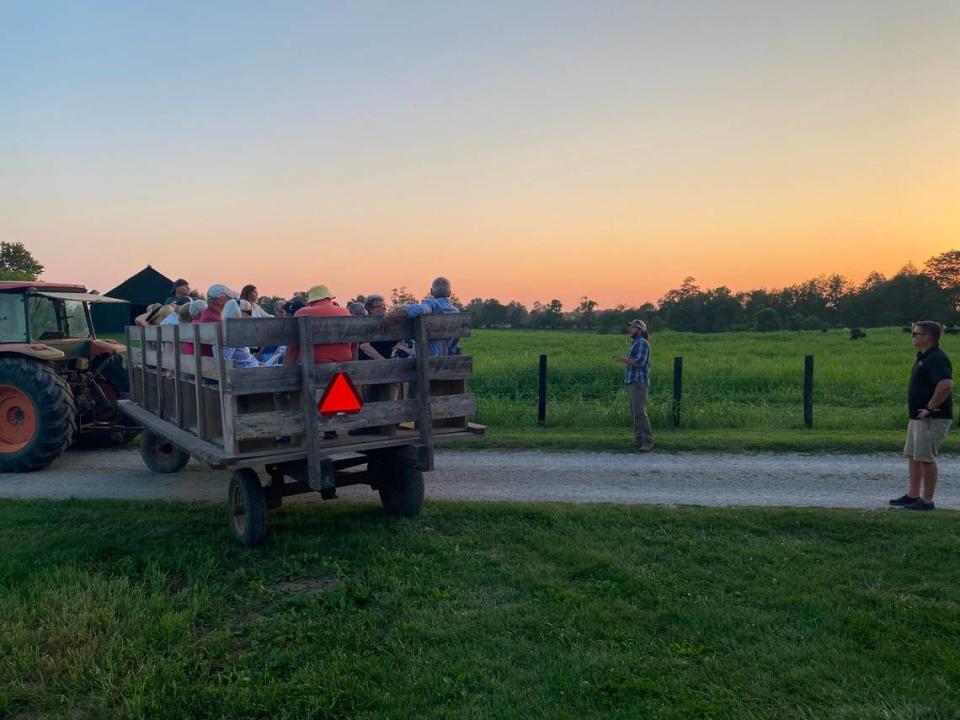This Kentucky farm received millions to help others raise climate friendly beef
There’s a chance the beef sitting on shelves in your local grocery store has traveled more than you lately. While it might’ve been raised anywhere in the U.S., that cow likely spent its final days in a feedlot out west before being processed and shipped again across the country.
According to the U.S. Department of Agriculture, a relatively small number of feedlots market 80-85% of the country’s fed cattle. Much of the cattle feeding operations are concentrated in the Great Plains.
A Kentucky farm is trying to provide a more-climate friendly alternative to that well-traveled beef. Mt. Folly Farm in eastern Clark County has been raising crops and cows — using “climate-smart” techniques — that will live out their lives on local pasture before being processed and sold locally.
“These cattle are different, because they’re feedlot free,” said Ben Pasley, the CEO of Mt. Folly Enterprises. “There (are) no antibiotics, no growth hormones and they live their entire life here.”
Mt. Folly Farm, along with Eastern Kentucky University and a bevy of other partners, received a nearly $5 million grant from the USDA to build a network of 100 farmers across the Ohio River Valley that would raise beef and other farm products using “climate-smart” techniques. As part of the grant, farmers will be financially incentivized to adopt more climate-friendly practices.
Mt. Folly Farm — which is owned by Laura Freeman, the founder of Laura’s Lean Beef — has been practicing climate-smart techniques for years. Part of the goal of the program will be to build a climate-smart beef brand that would launch next year.
“Wouldn’t it make more sense if (beef) was bought here, killed here, processed here, ate here?” Alice Melendez, the project lead for the grant, said at a tour Tuesday of Mt. Folly Farm.
What is climate smart?
Farmers can take on a range of land management practices which lower greenhouse gas emissions or trap more carbon, one of the gasses most commonly associated with global warming. The National Resource Conservation Service, a branch of the USDA, has a long list of “climate-smart” practices.
“As long as you’re implementing those practices, you’re climate-smart farming,” Melendez said in an interview.
The amount of carbon sequestered by those practices can be measured. Dylan Kennedy, a Kentucky farmer focused on regenerative agriculture and the grant’s field lead, will be in charge of going out to farms who join the program and gathering that data for the USDA. Kennedy is trained in land health by the Savory Insititute, a global anti-desertification non-profit.
Faculty and students at EKU will work to verify the data and make sure the grant’s mandates are followed. John Settimi, the EKU agriculture professor charged with the project, said the NRCS provides software that can model how much carbon is being stored by climate-smart practices. Additionally, they’ll be taking soil samples from farms to measure the carbon content.
Through photosynthesis, plants capture carbon “all the time,” Settimi said. Carbon can be trapped in the plant’s biomass and in the soil, reducing the amount in the atmosphere.
“The reason why the government is funding all this is because plants are essentially the absolute best way that we have right now of capturing carbon,” Settimi said.

What do climate-smart practices look like?
On a recent farm tour, Mt. Folly Farm demonstrated some of its climate-smart practices, many of which encourage carbon-absorbing plant growth.
Cattle there feed via rotational grazing, Kennedy said. Instead of allowing the cows to freely graze an entire field down to the dirt, temporary electric fencing is put up to limit their grazing to only a portion of the field at a time.
Meanwhile, grasses and cover crops in other parts of the field can grow and recover from previous grazing. The larger plants capture more carbon and when they eventually break down, will improve the health of the topsoil. The cows will graze on one portion for a few days before being moved into a different, more grown-up section of the field.
“Our goal is to have our livestock on less than 10% of our land at any given time,” Kennedy said.
The farm also makes and uses biochar – an ancient technique of burning organic materials at a high heat to produce a fine charcoal that can be spread in a field to improve soil health. They plant more trees around the farm and near streams — something they’re hoping to encourage grant participants to do more.
Many of these techniques may already be known to farmers but may not be fully implemented. A 2018 USDA survey estimated that a little under half of the livestock producers in Kentucky, Tennessee and Virginia use rotational grazing.
The grant would allow participating farmers an up to $10,000 cost-share assistance and a $1,500 incentive. Those interested can sign up on the Laura’s Mercantile website.

